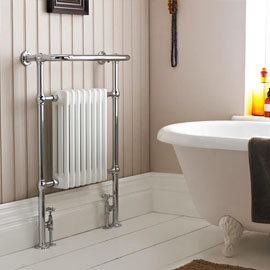OUR BOXING DAY SALE ENDS SOON!
Free delivery on orders over £499*
Traditional Column Radiators Buying Guide
Traditional Column Radiators Buying Guide
For Elegant Bathroom Heating, Browse This Ultimate Traditional Column Radiators
If you want a beautifully crafted, stylish accompaniment to your period bathroom fixtures, then installing a traditional column radiator is a great idea. The elegant designs of these items will really complement classically influenced settings and the best thing about them is that despite their expensive looking, often ornate appearance they are actually very affordable upgrades. In this guide, we'll pay attention to the key information you'll need to know if you're interested in buying a traditional column radiator.
So what are my options?
Column radiators come in many different styles, so picking the right one comes down to a matter of both personal taste and also the amount of space you have to spare in your bathroom.
There are portrait and landscape options out there, as well as more compact designs which will slot into smaller bathrooms easily. With regards to finishes, you can have anything from white, to a stylish black, to copper and pewter on the more Victorian inspired models. Make no mistake, these products will not only do a great job of keeping your bathroom nice and toasty, they'll also look amazing in the process!
How difficult are they to install?
Installing a traditional column radiator can be very tricky if you don't have previous experience, so we would recommend contacting a professional if you're not too confident tackling this yourself.
If you are happy undertaking this work yourself, then we'll explain the best method of installation. Firstly you need to make sure that both the old item and water supply are turned off. Next, you need to open old bleed valve. The bolts which hold the radiator to the valves then need to be undone before the bleed valve is closed again. The old radiator then needs to be drained, so lifting it and holding it over a bucket will do the job. Keep the old radiator in a place where it won't get in the way.
Now it's time to attach the radiator tails to the new radiator. These should be sealed with PTFE tape. Gently tighten the tails using a wrench for a secure fitments. You should then attach the radiator to the wall mounting brackets, but be careful not to scratch your tiling in the process. The flow and bleed valves will then need to be opened. Quickly nip and turn the water back on then wait for it to come through the bleed valve before closing this valve. Finally locate the return valve and open this in order to let water pass through the system to finish.
What is a BTU rating?
This is an important aspect which you need to pay attention to when selecting a new traditional column radiator. BTU stands for British Thermal Unit and this rating allows you see just how much heat a radiator will generate. The larger the number, the greater the amount of heat a radiator will give out.

